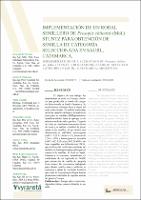Implementación de un rodal semillero de Prosopis chilensis (Mol.) Stuntz para obtención de semilla de categoría seleccionada en Saujil, Catamarca
Implementation of a seed stand OF Prosopis chilensis (Mol.) Stuntz for obtaining seeds of selected category in Saujil, Catamarca, Argentina
Date
2020-12-02Author
Verzino, Graciela E.
Frassoni, Javier E.
Castillo, Nidia
Joseau, María Jacqueline
Cólica, Juan J.
López Lauenstein, Diego
Verga, Aníbal
Metadata
Show full item recordAbstract
El objetivo de este trabajo fue implementar un rodal de Prosopis chilensis para producción de semilla de categoría Seleccionada en Saujil, Catamarca. Se recolectaron y midieron hojas y frutos del rodal seleccionado. El análisis multivariado de las variables de hojas y el análisis de isoenzimas de semillas (ADH) permitieron identificar árboles fuera de tipo que se eliminaron mediante raleo genético. Después del raleo, se cosecharon nuevamente frutos del rodal y se realizó el análisis de isoenzimas de las semillas, el que mostró una disminución de individuos heterocigotas (ADH - A23 P. chilensis x P. flexuosa) de 2,38 a 1,67% y homocigotas no deseados (ADH - A22 P. flexuosa) del 2,38 al 0%, valores aceptables por la Resolución 374/14, que establece las condiciones mínimas admisibles de homogeneidad genética para el comercio de semillas. El rodal de Saujil, Catamarca, se encuentra, actualmente, en condiciones de ser registrado en INASE para producción de semilla de categoría Seleccionada. De esta manera, trabajando para obtener semilla pura y uniforme se comienza a salvar la restricción histórica que existe en Argentina para lograr buenas plantaciones forestales de especies nativas del género Prosopis. The objective of this work was to implement a stand of Prosopis chilensis for the production of Selected category seed in Saujil, Catamarca. Leaves and fruits of stand trees were collected and measured. Multivariate analysis of leaf variables and the analysis of seed isozimes (ADH) allowed identifying out-of-type trees that were eliminated by genetic thinning. After thinning, fruits were harvested again and isoenzyme analyzis was performed on the seeds, which showed a decrease of heterozygous individuals (ADH - A23 P. chilensis x P. flexuosa) from 2.38 to 1.67% and homozygous (ADH - A22 P. flexuosa) from 2.38 to 0%, values acceptable by Resolution 374/14, which establishes the minimum admissible conditions of genetic homogeneity for seed trade. The Saujil, Catamarca stand is currently in a position to be registered in INASE for the production of Selected category seed. In this way, working to obtain pure and uniform seed begins to save the historical restriction that exists in Argentina to achieve good forest plantations of native species of the genus Prosopis.
Collections
- Revista Yvyraretá [360]
The following license files are associated with this item:



